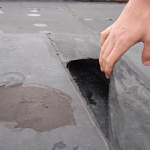Checking your Roof for Leaks
 If you’re not a trained roofer, checking your roof for leaks can be a frustrating task. If you have to cover the whole of the roof, it can take you hours to locate the source of the leak, especially if you’re working alone. When you think you have a leak in your roof, you can save time by checking specific areas where the leak is likely to occur.
If you’re not a trained roofer, checking your roof for leaks can be a frustrating task. If you have to cover the whole of the roof, it can take you hours to locate the source of the leak, especially if you’re working alone. When you think you have a leak in your roof, you can save time by checking specific areas where the leak is likely to occur.
The most vulnerable parts of a roof are around the perimeter and at the joints, around flashings and sealants. Around the perimeter of the roof is the area that takes the brunt of the weather as wind flows across the roof. The seals here should be checked often. These areas are vulnerable because of the change of materials used between the edges of the roof and the underside of the roof can create weak spots.
Flashings that have worn down can cause leaks. If flashings have come away or rusted, they can allow water to trickle in underneath the roofing. If you spot any rust on your flashings, it best to get them replaced as soon as possible before water damage causes problems to your roof or eventually the structure of your home.
Leaks can often occur at areas that overlap and around penetrations. These seams are the areas that you should check regularly. If you have a roof drain that penetrates the membrane, this is also a spot to watch. Other examples of penetrations are roof vents, plumbing and chimneys, which penetrate through the roof. It’s a good idea if you have roof accessories, to have them tailor made to ensure that the materials are compatible, which can help you to avoid leaks. There’s often a lot of rainwater around the roof drain, which can create an effect called ponding.
Make sure that your roof drain is functioning at its best to avoid problems in this area, and it should have a screen to ensure that debris does not become lodged inside. Regular cleaning can also help you keep your roof drain working well.
The same goes for all your guttering. Water that has been allowed to stand is always going to present a problem and potentially leak. So ensure that your gutters are working by having them serviced once a year, particularly prior to the winter months.
Checking Inside and Out
Sometimes it can be hard to find a leak. You can spot it easily enough inside your home – it will take the form of water stains, mould or black marks – but try as you might, you can’t find the leak on the outside of your roof. This is because the water may have run down in the inside of your roof before soaking in. It can sometimes help to find these leaks by following the course of the water, if you can. It can sometimes help to measure the stain against a point on your roof that will be easily identifiable from out outside, such as a chimney or a vent. These leaks can be even trickier to fix, because the water may have caused damage along the entire length of its trajectory. This is why it’s essential to fix leaking roofs quickly, before the damage becomes worse.
Don’t ignore small holes in your roof left over from satellite dishes or even missing nails. You may think that a small hole is harmless enough, but they can let in rain water and start rotting the structure of your roof, causing damage that you may not notice until you need a whole new roof.
If you’re an amateur DIYer, finding a leak in your roof can take up precious time. A professional roofer will be able to spot a leak quickly – they’ll know the areas that are most susceptible to leaks and what sort of damage to look for. To save you time and ensure that you get your roof fixed safely, contact a trained roofer. This way, you’ll be sure that the problem is securely fixed rather than a temporary repair that may not provide you with adequate protection.
G&A Roofing and Building is a leading roofing firm that offers roofing and home maintenance to local homes and businesses. Our trained roofers cover most of the UK, providing a quality service and affordable work for your property. Call G&A Roofing and Building to speak to a professional roofer for advice on 0800 626430.

 When you see this symbol you know you are dealing with a reputable roofing company
When you see this symbol you know you are dealing with a reputable roofing company